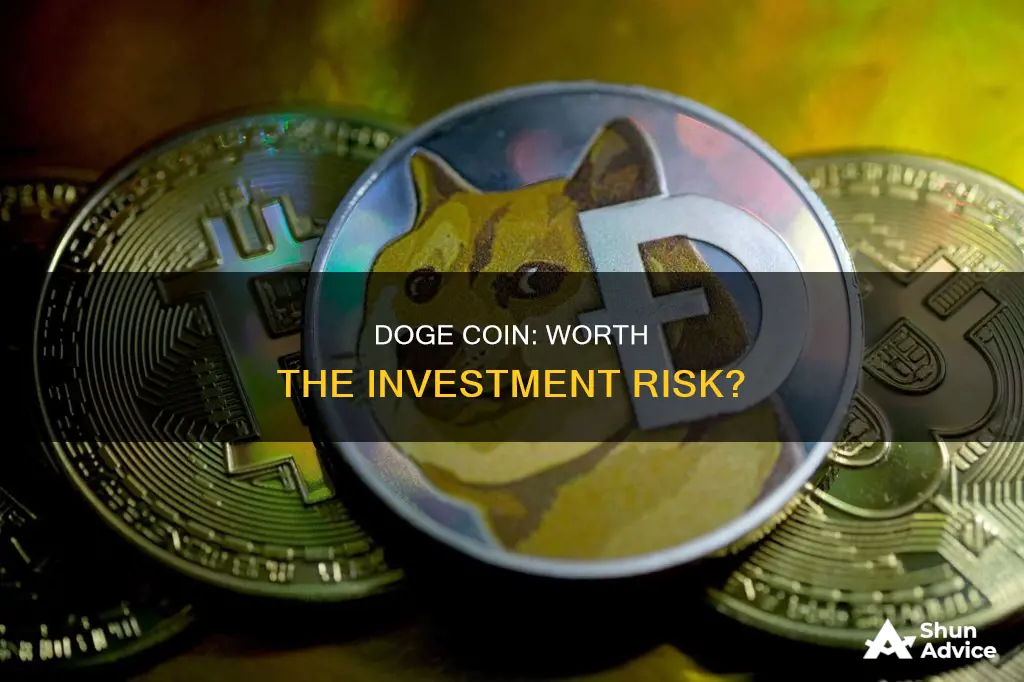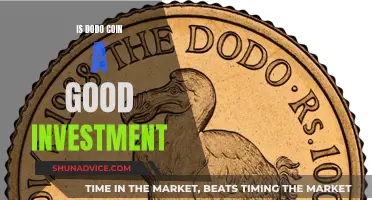
Dogecoin is a cryptocurrency that has been described as a meme coin. It was created by Billy Markus and Jack Palmer in 2013 as a joke, but it has since become one of the top 20 cryptocurrencies. Dogecoin's value has fluctuated since its creation, with a rapid rise in 2020 and 2021, a significant loss in value in 2022, and a nearly 30% increase in value in 2023. As of 2024, Dogecoin is still considered a risky investment due to its volatility and the potential for fluctuations in value. However, some analysts believe that it could be a good long-term investment, especially if its community continues to grow and it gains wider adoption. Dogecoin has several advantages, including its decentralised nature, convenience for everyday transactions, strong community support, and multiple exchange listings. On the other hand, its unlimited coin supply, potential for pump and dump schemes, and past neglect by its developer team are reasons for caution. Overall, Dogecoin may be a worthwhile investment for those who are willing to accept the risks and volatility associated with cryptocurrencies.
What You'll Learn

Dogecoin's volatility and potential for value fluctuations
Dogecoin is a highly volatile cryptocurrency. Its value is influenced by factors such as demand, trends, and market sentiment, which can cause its price to fluctuate rapidly. Dogecoin's volatility presents both opportunities and risks for investors.
The price of Dogecoin has experienced significant fluctuations since its creation in 2013. In its early years, Dogecoin had two short-lived price jumps, with the first occurring right after its launch, where its price soared 1,061% in 15 days from $0.0002 to $0.0023. The second big hike took place in March 2017, during the early stages of a crypto bull market, where its price rose by 1,494% to a peak of $0.004. However, these gains were short-lived, as Doge prices soon fell below $0.001.
Dogecoin saw huge gains in 2020 and 2021, creating millionaires, but it lost much of its value in 2022. In 2021, Dogecoin's price reached an all-time high of nearly $0.74, but it has since lost a significant portion of its value, settling around the $0.10 level. In 2023, Dogecoin experienced periods of heightened volatility, with its price increasing by nearly 30% due to a strong rally at the end of the year.
The volatile nature of Dogecoin and other cryptocurrencies is one of the main reasons experts consider them risky and speculative investments. Dogecoin's value can fluctuate drastically in a short period, and investors could suffer significant losses if the market turns against them. On the other hand, the volatility also presents opportunities for investors to make substantial gains if they can time the market correctly.
Dogecoin's future value depends on various factors, including new projects, community adoption, and celebrity endorsements. While it is impossible to predict Dogecoin's future price movements, its volatility is likely to continue, and investors should carefully consider their risk tolerance before investing in this highly volatile asset.
Strategizing Bitcoin Investment: A Long-Term Guide
You may want to see also

Dogecoin's status as a meme coin
Dogecoin is widely regarded as the first meme coin, created in 2013 by software engineers Billy Markus and Jackson Palmer. The name comes from a popular meme at the time featuring a Shiba Inu dog named Kabosu. The creators had no idea that Dogecoin would become one of the top cryptocurrencies by market cap.
Dogecoin is based on a picture of a Shiba Inu dog and the Comic Sans font. It operates similarly to Litecoin and Bitcoin, using a proof-of-work consensus mechanism to process transactions on the blockchain. Dogecoin is decentralised, meaning that no single person or entity has control over it. It allows users around the world to verify transactions and contribute computing power in exchange for a small reward in Dogecoin.
Dogecoin is one of the most well-known meme coins, with celebrity endorsements from the likes of Elon Musk and Snoop Dogg. The token saw huge gains in 2020 and 2021, creating millionaires, but lost a lot of its value in 2022. Dogecoin has seen over 40% growth since the start of 2024, and there is still potential for further growth.
Meme coins are cryptocurrencies that don't take themselves as seriously as leading digital currencies like Bitcoin and Ethereum. They are often cheaper than large-cap cryptocurrencies, making them more accessible to a wider audience. Meme coins thrive on hype and momentum as the community grows, and they are usually upfront about their status as a meme currency.
Meme coins are typically driven by group marketing and community engagement, presenting a lower barrier to entry than traditional cryptocurrencies. They are often created as a joke or for satirical purposes, but some have gained serious traction and become valuable. Dogecoin's explosion in popularity led to a growing number of dog coins, such as Baby Doge Coin and Shiba Inu.
Meme coins are considered high-risk investments due to their volatile nature, and their value is largely determined by the momentum they can generate and their ability to maintain their audience's interest. However, some investors view Dogecoin as a fun and unique investment opportunity, especially if they are investing with money they are willing to lose.
The Partial Bitcoin Investment Guide for Beginners
You may want to see also

Dogecoin's scalability and potential for widespread adoption
The future of Dogecoin's scalability and adoption hinges on several factors, including new projects, community adoption, and continued celebrity endorsement. If the community continues to push for Dogecoin as a payment option, it could lead to large-scale adoption and increase its price. Additionally, if the development team creates new projects that add real value to the token and attract new users, it could further enhance its scalability and potential for widespread adoption.
However, it is important to note that Dogecoin's scalability faces technical challenges. Ethereum co-founder Vitalik Buterin criticized Elon Musk's proposal to scale Dogecoin by increasing its blockchain speed, capacity, and reducing costs by tenfold. Buterin argued that this approach is "fundamentally flawed" as it would make the blockchain less secure and less decentralized, requiring more powerful hardware and faster internet connections to support the increased block size and transaction times.
Despite these challenges, Dogecoin has the potential to address these technical issues and improve its scalability. Buterin suggested a Dogecoin-Ethereum collaboration for scalability, highlighting the potential for a secure Doge-to-Ethereum bridge. He also mentioned the possibility of Dogecoin merging with an Ethereum proof-of-stake, which could be an interesting alternative.
In conclusion, Dogecoin has the potential for widespread adoption, as evidenced by its strong community and celebrity endorsements. However, its scalability faces technical challenges that need to be addressed through new projects and collaborations to ensure its long-term success and widespread adoption.
Investing in Bitcoin: Is $100 Enough to Get Started?
You may want to see also

Dogecoin's strong and growing community
Dogecoin has a strong and growing community that has been instrumental in its success. The community is dedicated to supporting each other, being kind, teaching people about cryptocurrency, fundraising, having fun, making memes, and embracing the absurd. This ethos is captured in Dogecoin's unofficial tagline: Do Only Good Everyday.
The community's strength was demonstrated in 2013, when Dogecoin.com became an instant hit, with over a million visitors in the first 30 days. Within two weeks, Dogecoin had established a dedicated blog and forum, and its market value reached $8 million, briefly becoming the seventh-largest electronic currency in the world.
Dogecoin's community has also been active in charitable fundraising. In 2014, they raised $36,000 to support the Jamaican Bobsled Team in the Sochi Winter Olympics, and also raised funds for another athlete, Shiva Keshavan. In the same year, the Dogecoin Foundation, led by Eric Nakagawa, collected donations to build a well in the Tana River basin in Kenya for World Water Day. The campaign raised over $30,000 from more than 4,000 donors.
In 2020, during the Covid-19 lockdowns, Dogecoin went viral on TikTok, bringing in new investors. This was followed by endorsements from celebrities such as Elon Musk, Snoop Dogg, and Gene Simmons, which further grew the community and contributed to Dogecoin's huge gains in 2020 and 2021.
Dogecoin's community continues to be a key factor in its growth and development, with a strong presence on social media platforms such as Reddit and Twitter. The community's dedication to the coin, combined with its fun and friendly nature, has made Dogecoin one of the most well-known and unique cryptocurrencies.
The Bitcoin Investment: Missed Opportunities and Future Prospects
You may want to see also

Dogecoin's status as a decentralised cryptocurrency
Dogecoin is a decentralised, peer-to-peer cryptocurrency. It was created in 2013 by software engineers Billy Markus and Jackson Palmer, who wanted to make fun of the wild speculation in cryptocurrencies at the time. Dogecoin is based on blockchain technology, a decentralised system of storing information as a public ledger that is maintained by a network of computers called nodes. This system is highly secure, and because it is decentralised, no single person or entity has control over it.
Dogecoin is a type of cryptocurrency known as a "meme coin", specifically a "dog coin", as it features the face of Kabosu from the "doge" meme as its logo and namesake. It was introduced on 6 December 2013 and quickly developed its own online community, with a dedicated blog and forum, and its market value reached $8 million within two weeks. Dogecoin is also known as the "people's crypto", and its decentralised nature means that it is a perfect example of crypto-techno-anarchy.
Dogecoin's decentralisation has several implications for its use. Firstly, it means that no one person or entity owns or controls it, so it is not subject to the influence of a central authority. This also means that it is not regulated like stocks, so actions such as Elon Musk's frequent tweets about Dogecoin, which often cause price movements, are not illegal.
Dogecoin's decentralisation also has implications for its security. As a decentralised system, Dogecoin is secure and protected from potential threats such as hacking or other malicious activities. This is because there is no central point of failure that could be targeted, and the network of nodes provides a distributed and resilient system for storing and verifying transactions.
Why You Should Avoid a Bitcoin IRA
You may want to see also
Frequently asked questions
Dogecoin is a highly volatile investment option. It has seen over 40% growth since the start of 2024, but it is important to approach investing in Dogecoin with caution due to its volatility and the potential for fluctuations in value.
Dogecoin is what is known as a "meme coin", which means its value is largely driven by social media hype and influencer endorsements. This makes it susceptible to pump and dump schemes and means its value can be particularly sensitive to comments made by high-profile individuals such as Elon Musk. Dogecoin also has an unlimited coin supply, which could weigh down on its price.
Dogecoin is one of the most well-known and established meme coins, and it has a strong and growing community of supporters. It is also highly scalable, convenient for everyday transactions, and is accepted by a growing number of major corporations. Dogecoin is also decentralised, which means it has no single point of failure.
Dogecoin can be purchased on multiple cryptocurrency exchanges, including Coinbase, Kraken, and eToro. It is also listed on Robinhood, which is a platform that is popular with Americans as a newbie-friendly broker.
It is important to remember that virtual currencies are highly volatile and your capital is at risk. You should only invest what you can afford to lose, and it is generally recommended to have a diversified cryptocurrency portfolio rather than investing all your money in Dogecoin or any other single cryptocurrency.







